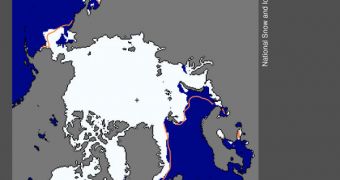In their monthly report on the situation of ices in the Arctic, experts in the United States show that overall ice decline for the month of April was less significant than the one recorded in March. Still, things got a little out of hand at the end of the month, they add.
That is to say, while melt rates maintained rather steady throughout April, they suddenly accelerated towards the end of the month. Most likely, this effect will be visible in the report covering May.
The statistics are put together by the US National Snow and Ice Data Center (NSIDC), which keeps constant tabs on a number of traits pertaining to the Arctic, the ocean around it, and surrounding areas.
Ice extent for April reached an average level of 14.15 million square kilometers (5.46 million square miles), which is some 850,000 square kilometers (328,000 square miles) below the reference average researchers use (1979 to 2000).
The areas that are most affected by the ice loss include the North Atlantic (the Barents Sea and the Greenland Sea), the Sea of Okhotsk and the Canadian Maritime regions, the NSIDC report explains.
“The eastern Arctic remained warmer than average all winter. This suggests that that sea ice there did not thicken as much as in past winters, and may retreat rapidly as the summer melt season progresses,” the investigators write in a press release.
“University of Washington's Pan-Arctic Ice Ocean Modeling and Assimilation System (PIOMAS) model of sea ice volume reflects this, showing continued very low ice mass in the Arctic compared to previous decades,” they go on to say.
Between 1979 and 2000, the average level of ice decline reached a value of 40,430 square kilometers (15,610 square miles) daily. The figures recorded by the American researchers indicated that the month of April saw a decline level of 29,950 square kilometers (11,560 square miles daily), lower than usual.
“Cool conditions helped retain ice in Baffin Bay, between Canada and Greenland. Most of the ice loss during April was in the Kara Sea, north of Siberia, and the northern Baltic Sea in Europe. Ice also retreated rapidly in the western Bering Sea and the Sea of Okhotsk,” the experts say.

 14 DAY TRIAL //
14 DAY TRIAL //